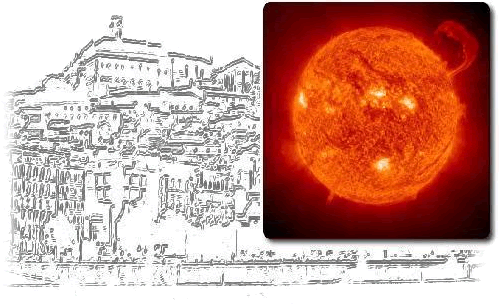|
T. Barata (1), P. Pina (2), S. Carvalho (1), R. Gafeira (3,1), Garcia A. (4,1); 1 - Centre for Earth and Space Research of University of
Coimbra, Coimbra, Portugal, 2 - Cerena, IST, University of Lisbon, Lisbon, Portugal, 3 - Max Planck Institute for Solar System Research, 4 - Geophysical and Astronomical Observatory of the
University of Coimbra, Coimbra, Portugal |
|
The success of several solar missions is allowing obtaining a huge amount
of high resolution images from the surface of the Sun. Therefore the use of to the
digital image processing techniques has increased accordingly with the aim of
getting information about the solar activity in a prompt and efficient way.
Several image processing and detection approaches have being developed and tested in
the last years. For instance, neural networks have been used to detect the solar
activity of the solar winds, protons events, with an automatic tracking of solar
flares. Thresholding techniques, region growing, edge detection, Hough transform,
and fuzzy sets have been applied in the detection of sunspots, active regions,
filaments and CMEs. Hybrid methods that include different approaches have also been
developed. Mathematical morphology has been applied to sunspots and in filaments?
recognition. A common aspect between all these works is the need to incorporate
pre-processing techniques, before the main processing and feature extraction task,
with the aim of homogenizing the solar images in terms of dimension, size and
intensity, and of removing the limb darkening.
The comparison between automatic and manual methods is presented in Zharkova et al.
(2005), proving the higher efficiency of the automatic methods. The developed
algorithms for filaments tracking and active regions survey, constitute the first
steps for the building of an approach that can allow the following of the solar
activity evolution. The advancements and results of these many applications, especially as sunspots are
concerned, have also contributed for the building of solar activity catalogues,
being the EGSO (European Grid of Solar Observations) a good example of this.
Nevertheless, in addition to have more data from the new instruments and space
missions, it is yet important to maintain older instruments working and to use their
data for several important reasons. One of them is the long-term observations of, at
least, several decades they have been performing, crucial to understanding the solar
cycle. Besides, ground-based observations allow us to preserve and extend consistent
data sequences.
The versatility of the automatic methods is also high, not only due to its ability
for characterizing and quantifying parameters of the solar activity, but also for
its applicability in any type of image (from high resolution to spectroheliograms,
for example). However, in what concerns ground-based images, the application of
automatic methods can present some additional difficulties, due the Earth's
atmosphere and meteorological factors.
The Geophysical and Astronomical Observatory of the University of Coimbra has a
collection of solar observations (spectroheliograms) that span dozens of years,
acquired on a daily basis since 1926 and already in digital format. This exceptional
collection must be processed since their importance for the knowledge of the solar
activity.
Given the different approaches, some of them already mentioned, this work aims to
evaluate the capability of some methods in the automatic detection of sunspots from
spectroheliograms. The objective of this work is to define a strategic action to be
applied to all spectroheliograms datasets.
In order to illustrate that strategy, a set of images belonging to solar cycle 24,
from October to November of 2014, was chosen to test and integrate several
algorithms, developed by different research groups, with quite different and
up-to-date approaches from image analysis and pattern recognition. The final results
will be compared to reference detections by an expert solar observer, to evaluate
the performances on the detection of the contour of sunspots, the ability to to
differentiate the umbra and spot areas, and also their numbers. According to the
best detection rate performances (its accuracy but also computational time, among
others), a processing chain will be implemented and applied to all long data series
of OGAUC. |



